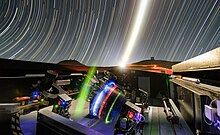| Revision as of 19:44, 1 November 2017 edit101.185.22.39 (talk)No edit summaryTag: wikilinks removed← Previous edit | Revision as of 03:28, 30 December 2017 edit undoMike s (talk | contribs)Extended confirmed users21,551 editsm updateNext edit → | ||
| Line 2: | Line 2: | ||
| == Planets discovered == | == Planets discovered == | ||
| The ''XO telescope'' has discovered |
The ''XO telescope'' has discovered six objects so far, five are ] planets and one, ], is probably a ]. All were discovered using the ]. | ||
| ''Light green rows indicate that the planet orbits one of the stars in a binary star system.'' | ''Light green rows indicate that the planet orbits one of the stars in a binary star system.'' | ||
Revision as of 03:28, 30 December 2017
The XO Telescope is a telescope located on the 3,054 m summit of Haleakala on Maui, Hawaii, formed by a pair of 200 mm telephoto lenses. It is used by the XO Project to detect extrasolar planets using the transit method. It is similar to the TrES survey telescope. The construction of the one-of-a-kind telescope cost $60,000 for the hardware, and much more than that for the associated software.
Planets discovered
The XO telescope has discovered six objects so far, five are hot Jupiter planets and one, XO-3b, is probably a brown dwarf. All were discovered using the transit method.
Light green rows indicate that the planet orbits one of the stars in a binary star system.
| Star | Constellation | Right ascension |
Declination | App. mag. |
Distance (ly) | Spectral type |
Planet | Mass (MJ) |
Radius (RJ) |
Orbital period (d) |
Semimajor axis (AU) |
Orbital eccentricity |
Inclination (°) |
Discovery year |
|---|---|---|---|---|---|---|---|---|---|---|---|---|---|---|
| XO-1 | Corona Borealis | 16 02 12 | +28° 10′ 11″ | 11.319 | 600 | G1V | XO-1b | 0.9 | 1.3 | 3.941534 | 0.0488 | 0 | 87.7 | 2006 |
| XO-2N | Lynx | 07 48 07 | +50° 13′ 33″ | 11.25 | 486 | K0V | XO-2Nb | 0.57 | 0.973 | 2.615838 | 0.0369 | 0 | 88.58 | 2007 |
| XO-3 | Camelopardalis | 04 21 53 | +57° 49′ 01″ | 9.91 | 850 | F5V | XO-3b | 11.79 | 1.217 | 3.1915239 | 0.0454 | 0.26 | 84.2 | 2007 |
| XO-4 | Lynx | 07 21 33.1657 | +58° 16′ 05.005″ | 10.78 | 956 | F5V | XO-4b | 1.72 | 1.34 | 4.12502 | 0.0555 | 0.0024 | 88.7 | 2008 |
| XO-5 | Lynx | 07 46 51.959 | +39° 05′ 40.47″ | 12.1 | 881 | G8V | XO-5b | 1.15 | 1.15 | 4.187732 | 0.0508 | 0.0029 | 86.8 | 2008 |
| XO-6 | XO-6b | 2016 |
See also
A subset of XO light curves are available at the NASA Exoplanet Archive.
Other Ground Transit Surveys

- Next-Generation Transit Survey
- Trans-Atlantic Exoplanet Survey or TrES
- HATNet Project or HAT
- Kilodegree Extremely Little Telescope or KELT
- SuperWASP or WASP
References
- McCullough, P. R.; et al. (2005). "The XO Project: Searching for Transiting Extrasolar Planet Candidates". Publications of the Astronomical Society of the Pacific. 117 (834): 783–795. arXiv:astro-ph/0505560. Bibcode:2005PASP..117..783M. doi:10.1086/432024.
- McCullough, P. R.; et al. (2006). "A Transiting Planet of a Sun-like Star". The Astrophysical Journal. 648 (2): 1228–1238. arXiv:astro-ph/0605414. Bibcode:2006ApJ...648.1228M. doi:10.1086/505651.
- Burke, Christopher J.; et al. (2007). "XO-2b: Transiting Hot Jupiter in a Metal-rich Common Proper Motion Binary". The Astrophysical Journal. 671 (2): 2115–2128. arXiv:0705.0003. Bibcode:2007ApJ...671.2115B. doi:10.1086/523087.
- Johns-Krull, Christopher M.; et al. (2008). "XO-3b: A Massive Planet in an Eccentric Orbit Transiting an F5V Star". The Astrophysical Journal. 677 (1): 657–670. arXiv:0712.4283. Bibcode:2008ApJ...677..657J. doi:10.1086/528950.
- McCullough, P. R.; et al. (2008). "XO-4b: An Extrasolar Planet Transiting an F5V Star". arXiv:0805.2921. Bibcode:2008arXiv0805.2921M.
{{cite journal}}: Cite journal requires|journal=(help) - Burke, Christopher J.; et al. (2008). "XO-5b: A Transiting Jupiter-sized Planet with a 4 day Period". The Astrophysical Journal. 686 (2): 1331–1340. arXiv:0805.2399. Bibcode:2008ApJ...686.1331B. doi:10.1086/591497.
- https://arxiv.org/abs/1612.02776 Discovery of XO-6b: a hot Jupiter transiting a fast rotating F5 star on an oblique orbit
- "New Exoplanet-hunting Telescopes on Paranal". www.eso.org. European Southern Observatory. Retrieved 14 January 2015.
External links
- The XO Project website
- Astronomers Catch Planet By Unusual Means (SpaceDaily) May 19, 2006
| Exoplanet search projects | |||||||||||
|---|---|---|---|---|---|---|---|---|---|---|---|
| Ground-based |
|   | |||||||||
| Space missions |
| ||||||||||
| Related | |||||||||||
This extrasolar-planet-related article is a stub. You can help Misplaced Pages by expanding it. |
This article about a specific observatory, telescope or astronomical instrument is a stub. You can help Misplaced Pages by expanding it. |